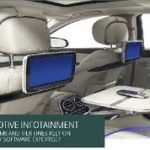“Intelligent plastics,” which replace printed circuit boards through the integration of electronic circuitries directly on top of plastic components, are moving from cellphones into automobiles.
Automotive Industries (AI) asked Tamim Sidiki, Global Marketing Director Electronics, DSM Engineering Plastics, what the main advantages are of intelligent plastics.
Sidiki: The beauty is that is 3D technology, which can be molded to any shape. You save space by printing on top of components. From a temperature performance point of view you can re-flow solder components because the substrate melts at higher than 260 – 290oC.
AI: What are the benefits in terms of safety, reliability and the environmental aspects?
Sidiki: Safety-critical components fail in part because of contact defects. Every connector and every cable is a source of potential failure – particularly after years of temperature cycling and vibration. The easiest way to increase safety and reliability is to simply take away those interconnects. With intelligent plastics a printed line replaces wires, and connectors are replaced by soldering the component directly onto the plastic.
From an environmental perspective what people don’t want to have is plastics emitting organic vapors because they can corrode the bonding wires, leading to a malfunction in the electronic circuitry. Our plastic has a high glass transition (TG) temperature, and does not need ionic stabilizers, and is entirely halogen free. Furthermore, it is the only polyamide to be certified at moisture sensitive Level 1 (MSL 1) offering infinite shelf life time for components. It is the ideal material for re-flow soldering, and offers both reliability and a high yield. It combines the best of both liquid crystal polymers and polyamide mechanics.
AI: Please explain the process.
Sidiki: The plastic is pretty much the same material as is used at present for components, but with the inclusion of a small amount of an additive which makes the material sensitive to infrared laser. It is a three-step process: you first mold your part, then you print and activate the surface with an infrared laser. In the final stage you put the component in an electroless galvanic bath where you grow the metal circuits, which typically start with copper, and then with a nickel layer and gold flash to avoid corrosion. This process allows complete design freedom, while automatically increasing safety and reliability.
AI: How do intelligent plastics contribute to integrated design and miniaturization of components?
Sidiki: That works on several levels. Typically, in the mobile world you have on average 12% reduction in part height year on year. Much the same is happening in the automotive sector because a lot more electronics are being integrated into cars.
Space in the car is becoming premium. The more you can shrink the better. If you look at radar, current radar technology is working at 25Ghz. The new technology in the introductory phase is working in 76 GHz, which offers the advantages of better resolution and a smaller antenna. So, using the bumper you can now double or triple the number of sensors, while reducing the cost and increasing the resolution. The increasing concentration of electronics in the same limited space means that you need to both miniaturize and use different types of materials with higher flow.
AI: What are the challenges for active thermal management?
Sidiki: There is both passive and active thermal management. For active cooling we are working on the cooling pipes. Polyamides are pretty strong, and if you have the necessary space to integrate the component it is not a big challenge. The passive thermal management is more challenging, with aluminum heat sinks being used. Since the aluminum is relatively heavy there is trend away from metal covers. Traditionally most ECUs have metal covers. Metal however have two advantages – it passively conducts heat away, and is electrically conductive. Many of the ECUs – specifically the car computer type like NVIDIA is designing – need EMI shielding. So, the first challenge is to combine passive thermal management to keep ductility pretty high and to make high conductivity components that can also survive a crash test. The second challenge is to integrate EMI shielding, but to keep it economically viable. We are working on such materials closely with some key customers.
AI: What DSM materials are being used in automotive electronics.
Sidiki: We’ve been active in automotive for the last 30 years. It started with structural components in the high temperature area, such as under the hood. Typically today 90% of the cars use DSM materials. A lot of the cables and components like lighting systems, antennas, sensors and connectors are made of DSM materials.
AI asked Hans Plug, New Business Development Manager at DSM Dyneema what is Carbon with Dyneema®?
Plug: Dyneema®, the world’s strongest fiber™ is DSM’s premium brand for Ultra High Molecular Weight PolyEthylene (UHMWPE) fiber, UD, flexible composite, tape and fabric. Dyneema® combines maximum strength with minimum weight. Carbon with Dyneema® is an improvement on the standard carbon composite material. Carbon and glass fiber based composites are used to reduce weight in the car. Carbon composite material is, however, still expensive and does not yet have the perfect mechanical properties as it is a relatively brittle material. Dyneema® fiber serves to reinforce the carbon hybrid composite fabric. Carbon with Dyneema composite is typically made of hybrid composite fabric impregnated with epoxy resin. The addition of Dyneema® fiber significantly reduces its brittleness. The material becomes much more ductile. It can absorb more energy upon impact, which helps improve the crash performance. The energy required to break it is at least double the impact energy it is able to absorb. Carbon composite reinforced with Dyneema® also lowers vibration on components by absorbing energy, which in turn reduces overall vibration and noise in a car.
Ai: How do you leverage the fiber’s properties for different end uses?
Plug: Typically Dyneema® fibers are used in ballistic materials because of the very high impact resistance. Those properties are quite different from carbon. Carbon fiber is more about structural stiffness and strength. By combining these two you get the benefits of carbon with the high impact of Dyneema®. And that results in a new material, carbon with Dyneema®. Ten years of research have helped us to understand how to blend Dyneema and carbon to obtain specific properties in composite materials. It was launched in 2016, and it is already being used for commercial applications in sport and racing.
AI: How does the material improve the performance of pure carbon composites in terms of weight, impact resistance, ductility and vibrating dampening?
Plug: The impact resistance and the vibration dampening more than doubles, and even the weight goes down a little bit because Dyneema® is lighter than carbon. Safety is the main benefit.
AI: What’s next for DSM?
Sidiki: We see our future in automotive in an extremely positive way. There are a lot of changes coming in which hold a lot of risk for many players. We see these changes as a real opportunity as two worlds are merging together, and we have a very strong footprint in both of them. There will be a lot more electronics in vehicles, and electronics are basically our bread and butter. We can use our skills and know-how to assist designers of connected and autonomous cars in particular to reduce design time. Just recently two big OEMs have introduced our LDS technology in the lighting systems of new models. It has never been used in auto lighting before.
Our material is used for all the electronic circuitry and LEDs for the interior lighting, as well as for the illumination of the number plates. Our material can also help OEMs manage the growing number of sensors and other electronic components. The more electronics are integrated, the more cables you need and the more connectors you need. Intelligent plastics can help manage the complexity and reduce the risks of component failure due to faulty connections. Our materials can also help with the thermal management of e-motors and electric drivetrain, as well as battery enclosures.














































 Saxony reinventing itself as home of electro-mobility
Saxony reinventing itself as home of electro-mobility TomTom shifts gear from consumer to B2B focus
TomTom shifts gear from consumer to B2B focus In-car Android system now available
In-car Android system now available CPU and operating system-agnostic middleware reduces time to market
CPU and operating system-agnostic middleware reduces time to market Cinemo Empowering Next Generation Android Automotive Platforms at CES 2018 in Las Vegas
Cinemo Empowering Next Generation Android Automotive Platforms at CES 2018 in Las Vegas ABS PLATING ON PLASTIC RECYCLING BREAK THROUGH!
ABS PLATING ON PLASTIC RECYCLING BREAK THROUGH!


